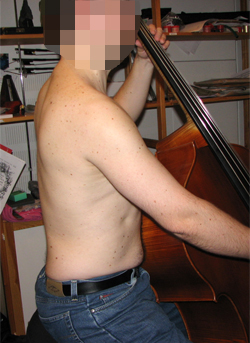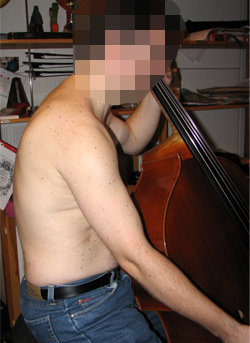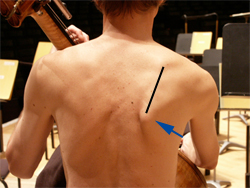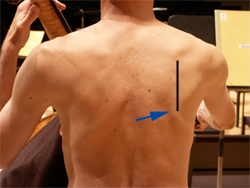Double bass - harjoittelu
Double bass
Read the Ergonomics Overview first.
The body's centre position is the basic position to which the musician always returns. In the centre position, the spine maintains its natural curves. Spinal curves vary between individuals; in the centre position, the backs and hips of different people may look different.
Double bass players should first examine the position of the pelvis and the spine. The seat height should be such that the pelvis stays in the centre position. The correct position of the pelvis and the lumbar spine enables good muscular support in the lumbo-pelvic (midriff) region. When the pelvis is in the centre position, the ischia point directly downwards, against the seat of the chair. When playing the double bass, the pelvis is prone to tilting backward and the spine curves forward, which can often cause lower back pain to the musician.
|
Pelvis and spine in the centre position. |
The pelvis tilts back and the back curves forward; the head pushes forward. |
In a standing playing position, it is easier to control the pelvic centre position, as the arms have better reach. Musicians who are smaller - especially those with short arms - are often prone to twisting and tilting their body forward. Therefore, a correctly sized instrument is the key to ensuring a good posture. When playing at the bottom end of the finger board with the left hand, almost the entire spine is curved; when playing at the top end, the spine extends back to the centre position. In addition, double bass players are prone to twisting their spine to the left, especially when playing the G string with the bow and/or when the left hand moves up the neck. The twisting motion should be avoided whenever possible, and the spine should always be returned to the centre position.
Supporting the left shoulder blade against the ribs becomes more difficult if the body is twisted to the left or the spine is curved. Good control of the shoulder blade support muscles is important for hand strength. Pushing the strings requires a strong hand as well as good muscular support in the shoulder blade. Good control of the bow hand also depends on the shoulder blade being well supported. When the spine curves forward, the shoulder blade tilts forward, preventing its natural rotation and/or causing it to wing off of the ribs. A faulty position of the shoulder blade can cause pain in the neck, shoulder and blade area.
|
The right shoulder blade is poorly supported against the rib cage. The shoulder blade tilts forward, wings off of the rib cage, and the medial inferior angle (bottom corner) rotates towards the spine. |
Shoulder blades are correctly supported against the rib cage. |
The hand arches should be maintained during playing for the palmar muscles to function correctly. The knuckles form a wide traverse arch, with knuckle 5 staying up and sufficiently far from the centre of the palm. The thumb remains curved, clearly away from the palm. The wrist should be in the centre position (extended by 15 degrees and tilted towards the little finger by 15 degrees). Maintaining the arches is particularly important in the left hand, as pushing the strings requires a lot of strength. The thumb follows the fingers on the instrument neck. If the metacarpal bones drop, the fingers produce less power and the finger muscles extending over the wrist become overstrained. Excessive flexing of the middle thumb joint should be prevented by increasing the use of the muscles in the base thumb joint which support the middle joint.
There are different bow grips. In the French grip, the shoulder blade is prone to tilting forward; in the German grip, the shoulder blade tends to wing off when playing at the heel of the bow. However, in both techniques, it is possible to prevent the faults by controlling the shoulder blade muscles correctly.




